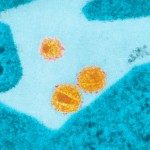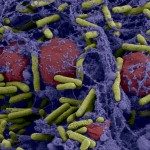Link to Pubmed [PMID] – 15855154
J. Biol. Chem. 2005 Jun;280(25):23698-708
Dengue virus (DV) is a mosquito-borne flavivirus that causes hemorrhagic fever in humans. In the natural infection, DV is introduced into human skin by an infected mosquito vector where it is believed to target immature dendritic cells (DCs) and Langerhans cells (LCs). We found that DV productively infects DCs but not LCs. We show here that the interactions between DV E protein, the sole mannosylated glycoprotein present on DV particles, and the C-type lectin dendritic cell-specific intercellular adhesion molecule 3-grabbing non-integrin (DC-SIGN) are essential for DV infection of DCs. Binding of mannosylated N-glycans on DV E protein to DC-SIGN triggers a rapid and efficient internalization of the viral glycoprotein. However, we observed that endocytosis-defective DC-SIGN molecules allow efficient DV replication, indicating that DC-SIGN endocytosis is dispensable for the internalization step in DV entry. Together, these results argue in favor of a mechanism by which DC-SIGN enhances DV entry and infection in cis. We propose that DC-SIGN concentrates mosquito-derived DV particles at the cell surface to allow efficient interaction with an as yet unidentified entry factor that is ultimately responsible for DV internalization and pH-dependent fusion into DCs.


